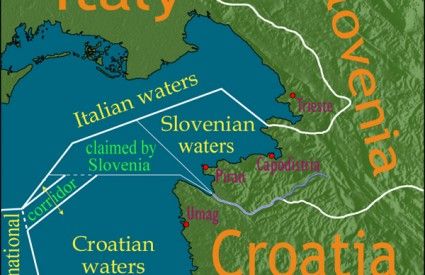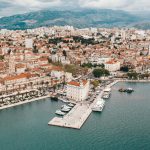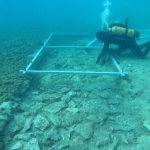A look at relations between Croatia and Slovenia.
In the early 1990s, Croatia and Slovenia were partners in their efforts to break away from Yugoslavia and become internationally recognized independent states. Now, 25 years later, long after succeeding in their initial goal, they are far from friendly. While relations between the two peoples are quite good, as evidenced by a large number of Slovenians spending their summer holidays in Croatia and a relatively large number of Croats going to Slovenia for skiing trips, the two governments seem intent on trying to create as many problems as possible. While the list of solved problems is almost non-existent, the list of open issues grows by the day. Here are just some of the major ones.
Border dispute
The issue which is most likely to cause major upheaval in relations between the two countries in 2017 is the border dispute. It all started after the dissolution of former Yugoslavia, which had strictly defined borders with neighbouring countries, but internal borders between individual republics were not marked and were open to a degree of interpretation. This has opened a can of worms, with newly-independent states arguing among themselves over territory. While disputed areas are usually quite small, they present a major problem for governments, since they fear being labelled as “traitors” if they give away even an inch of territory which their voters consider as “theirs”.
Croatia has border disputes with all of its neighbouring former Yugoslav republics, but the most important ones are those with Slovenia. Some of them relate to the border on land, particularly in the Žumberak area and in Istria. However, it is the sea border in the Bay of Piran which is in the focus of attention.

At issue is whether the border should follow the middle line between Croatian and Slovenian coast (which would mean that Slovenian sea would border just Italy and Croatia), or should be drawn in a way which would allow Slovenia to reach international waters. The dispute has been unsolved since early 1990s, with occasional incidents at sea between police and fishermen’s boats. There were repeated attempts by the two governments to come to an agreement, but they would inevitably be impeded by pressure from the media and public against any compromise.
Slovenia knew that the best time for agreement to be reached was during Croatia’s accession negotiations with the European Union. Since Slovenia had entered the EU earlier, it was able to blackmail Croatia and that is exactly what it did in 2008 when it blocked the negotiations. The move caused a complete breakdown in relations, with Croatia accusing Slovenia of hostile behaviour. After Ivo Sanader, Croatian Prime Minister at the time, resigned in July 2009, new Prime Minister Jadranka Kosor made the unblocking of negotiations a priority.
Later that year, Kosor reached an agreement with Slovenian government that negotiations would continue and that the border dispute would be decided by arbitration proceedings at the Permanent Court of Arbitration in the Hague. In return, Slovenia unblocked the negotiations and Croatia became a member of the European Union in 2013.
For a while tensions calmed down. However, it was becoming increasingly clear that the arbitration tribunal would probably rule in favour of Slovenia, at least regarding the sea border, particularly since the agreement between Slovenia and Croatia mentioned that Slovenia would have a “junction” with international waters. And then, in July 2015, media published secret recordings which proved that supposedly independent Slovenian arbiter was in collusion with Slovenian Foreign Ministry. Croatia immediately jumped at the chance and announced that the arbitration had been “irrevocably compromised” and that Croatia would no longer take part in it nor would accept any ruling.
The Slovenian arbiter and an official at the Foreign Ministry resigned, effectively admitting their guilt, but Slovenia argued that the arbitration should continue nevertheless. After some deliberation, the tribunal agreed with Slovenia and announced that the proceedings would continue. But Croatia is still refusing to have anything to do with it.
The key question is what will happen once the tribunal issues its verdict, which will probably happen later this year. One possibility is that the ruling will go in favour of Croatia, which would probably end the whole controversy (no doubt, Croatia would suddenly change its mind and accept such ruling). But, it is much more likely that the ruling will be in favour of Slovenia (at least regarding the sea border). While Slovenia has announced that it would implement the decision within six months of it being announced, it is not sure what will be the reaction of Croatian government if Slovenia, for example, sends its navy or police to the disputed waters.
Just a few days ago, Slovenian Foreign Minister indirectly threatened that Slovenia could make problems for Western European tourists who have to pass through Slovenia to reach Croatian coast and in that way jeopardize Croatian tourism industry. While the minister later denied that he was threatening anyone and it is likely that Western European countries would not allow such behaviour toward their citizens anyway, no one knows what will really happen, but it will certainly not be anything pleasant.
Border fence
Border represents a problem for Slovenia and Croatia even in those areas where it is not in question. After a wave of migrants and refugees started passing through Croatia and Slovenia in late 2015, Slovenia was worried that Austria, the next country on the migrant route, might close its borders and that tens of thousands of migrants might stay on its territory. After unsuccessfully trying to get Croatia to limit the number of migrants who were being transported over the border (Croatia also did not want to become a migrant hotspot), Slovenia started constructing a fence on part of the border with Croatia. All in all, 187 kilometres of the fence have been built, although the whole land border is 668 kilometres long. However, since the migrant wave died down soon after the construction started, it actually never had any purpose and is currently just an embarrassing reminder of the migrant crisis.
In the last year, there were occasional reports that the fence might be removed, however, Slovenian officials claim there is still need for it, since it is possible that the migrant wave could be repeated. The fence has caused numerous protests from NGOs and local population on both sides of the border, but it does not seem very likely that it will be removed anytime soon.
Motorway between Austria and Croatia
As a form of pressure on Croatia, Slovenia has often used the fact that it stands on transport routes from Croatia to Western Europe. One of the key issues in this regard is the still uncompleted motorway between Austria and Croatia, which is important not only for Croatian tourism (since hundreds of thousands of tourists would use it every year to reach Croatia), but also for the wider economy, since it is part of one of the major routes linking Western Europe, Balkans and the Middle East.
After many years of obviously intentional delays, Slovenia relented under pressure and in 2009 finished construction of a part of the route. However, the final part of the motorway, which should connect to Croatian motorway system at Macelj border crossing, has still not been completed. Slovenian government claims that it is “doing all it can” to complete the motorway as soon as possible, and the latest plans are that it might be finished by the end of 2018.
Krško Nuclear Plant
Former Yugoslavia had one nuclear power plant, opened in early 1980s in Krško, a small Slovenian town on the border with Croatia, less than 40 kilometres from Zagreb. It was built jointly by Slovenia and Croatia, and the ownership is split 50-50. The power plant should be closed in 2043, but both countries should start building storage facilities for nuclear waste much earlier. Actually, they were already supposed to do it. The waste will also be divided by the two countries, but Croatia seems unable to make a decision whether it will build its own storage facility (and where it will be located, since nobody wants it), or whether it will make a deal with Slovenia to expand the storage facility there and pay half of the costs. Slovenia is complaining that Croatia is not taking its share of the burden of running the nuclear power plant, although it receives half of the electricity produced by Krško.
For a while, there were also arguments and lawsuits regarding the price of electricity which Croatia should pay, which included a period when Slovenia stopped sending electricity to Croatia, but that was all supposedly settled in early 2000s.
Ljubljanska Banka
In former Yugoslavia, Slovenia was economically the most developed republic and many believed that its banks were the safest in the country. That is the reason why many people from other parts of the country, including Croatia, decided to keep their foreign currency savings in Slovenian banks, particularly in Ljubljanska Banka. However, in early 1990s, after the dissolution of Yugoslavia, Slovenia took the money from the bank, declared it bankrupt, and used the money to found a new bank called Nova Ljubljanska Banka (New Bank of Ljubljana). It told the former bank’s clients that their savings were lost and that they should demand compensation from their own governments.
After many years of lawsuits, an international court ruled that Slovenia must pay about 385 million euros to 136,000 former clients of the bank from Croatia. The process of payment is still ongoing, but people will get some of their money back (at least those who were lucky enough not to die in the meantime).
Terrano
Compared to other issues, perhaps the Terrano wine does not seem too important, but it certainly is for winemakers in Istria for some of whom this is their livelihood. Before Croatia joined the EU, Slovenia protected at the European level the Terrano name as a Slovenian product, meaning that no one beyond Slovenian producers can sell wine under that name. Croatia appealed the decision, noting that Slovenia had no right to protect Terrano, since in Croatian part of Istria the wine is produced from a different variety of grapes. Just a few days ago, the European Commission reportedly accepted Croatian arguments and ruled that Croatian winemakers can also use the name, under certain conditions. Slovenian government has already announced that, if such a decision is indeed officially adopted, it would file a lawsuit against the European Commission at the European Court of Justice.
There are also many other more or less important issues between Croatia and Slovenia for the two governments to argue about. And, given that both countries like to spite each other, the list is only going to grow longer.







